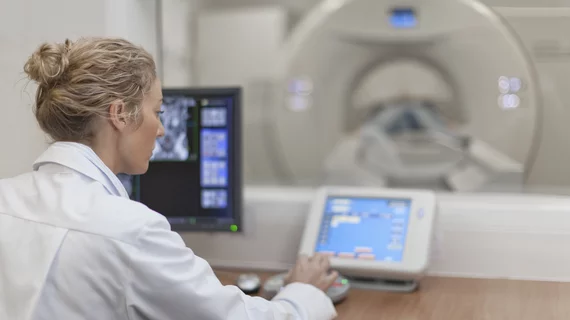Accelerated MRI sequence reduces scan times by one-third while maintaining image quality
An accelerated MRI sequence can reduce overall scan times by about 32% while maintaining image quality, according to an analysis published Aug. 28 in Academic Radiology [1].
This change in regular clinical practice could help to increase scanner throughput, leading to decreased costs, patient discomfort and motion artifacts, experts noted. For the study, scientists at Singapore Hospital utilized compressed sensitivity encoding, or SENSE, a common approach which involves random undersampling of MRI data.
A team of six subspecialized radiologists rated a set of 95 MR images from different anatomical regions, obtained using compressed SENSE, against others gathered via the standard protocol sequence.
“[Compressed SENSE] sequences were nearly equivalent to standard-of-care sequences and were largely deemed acceptable for daily routine clinical work,” Pohchoo Seow, PhD, with the Department of Diagnostic Radiology at Singapore General, and co-authors concluded. “The implementation of CS improved the existing clinical workflow and has wide scoping potential to enhance patient care and comfort by reducing MRI sequence acquisition time and shortening total scan time while maintaining image diagnostic quality.”
The six expert readers received anonymized paired sequences of images, achieved using the two methods, and randomly displayed side-by-side for comparison. They rated the results based on perceived sharpness, signal-to-noise ratio, lesion conspicuity and artifacts.
Compressed SENSE reduced overall scan times by about 32% while maintaining acceptable MRI quality for all regions, the authors reported. Spine imaging saw the largest time savings at an average of 68 seconds, or down 44%, followed by brain MR (86 seconds/37%). Intracranial 3D time-of-flight magnetic resonance angiography saw the maximum time savings at an an average of 202 seconds, a 56% drop.
Readers rated compressed SENSE as mildly inferior to the standard protocol sequence on perceived sharpness, signal-to-noise ratio and lesion conspicuity. But they deemed overall image quality as equivalent for joint and body scans and “slightly less” for brain and spine, though still diagnostic, the study found.
“Good overall clinical acceptance for CS (88%) was noted with full clinical acceptance for body scans (100%) and high acceptance for other regions (68%-95%),” the study reported.
Read more, including potential limitations, in Academic Radiology at the link below.

